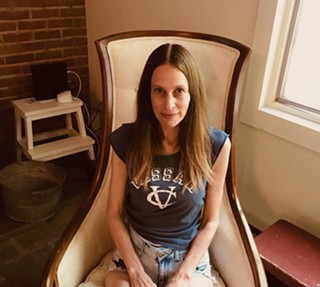The combination of home visits and a hospital birth is not always standard practice among midwives; many see their prenatal and postpartum clients only at the office. But for Hudson Valley Midwifery, it was a strategic choice. "When we decided to add hospital births [to our practice], we wanted to give the same style of care that we gave to our home-birth mothers," says Rannestad. After years of delivering in private homes, Rannestad feels a bit like a fish out of water in the hospital. "I'm not used to having nurses do things, and the nurses aren't used to having a provider who does things. If I want a glove, I get up and get a glove. I get lubricating jelly and put it on. They're like, what's she doing? I clean up—they think I'm a nut because of that. They also say our births are so sweet and calm and loving."
What's difficult for Rannestad is seeing things happen in the hospital that interrupt the baby's natural cycle in the first hours of life. "I feel that babies were born to be in the arms of people who love them, not in a little plastic box two feet away from its mother," she says. Yet she embraces Kingston for taking steps to become Baby-Friendly—a designation that recognizes and rewards birthing facilities that offer an optimal level of care through breastfeeding support and mother-baby bonding. "The commitment to that at HealthAlliance is top-notch. They are really committed to being Baby-Friendly and making a safe place in Ulster County to give birth."
True Care, True Community Service
Another team that practices at Kingston, Capital Region Midwifery (CRM), offers care that combines a hospital experience with traditional midwifery in a different kind of way. "We're experts in the hospital," says Liz Pickett, who with her partner Megan O'Connor opened CRM's Kingston branch earlier this year (CRM also has offices in Troy, Latham, and Clifton Park). "We're more comfortable in a hospital setting because we feel like there's more help if something goes south. Babies need to be resuscitated, moms have postpartum hemorrhages, and as much as you can take care of those things in a home setting, it's much nicer to know that if you need a staff blood transfusion you don't have to transfer to a hospital. The services that you need are right there." Focusing exclusively on hospital births also lets Pickett and O'Connor reach a demographic of people with fewer resources. "I want to serve the underserved," says Pickett, whose group offers free breastfeeding and education classes and takes just about every kind of insurance, including Medicaid.
For Pickett—who worked as a perinatal educator for local social-service agencies before becoming a midwife—getting privileges at Kingston was like coming home. Earlier in her midwife career she worked for a large, doctor-run practice at one of the region's largest, busiest hospitals. "I couldn't practice real midwifery care there at all," she says. "They had a tub room but the nurses never wanted us to use it, because they charted patients so much that they wanted us to stay near the computers. So water birth and hydrotherapy, these things that midwives do, we couldn't really offer that." Fear of liability meant that the nurses were constantly hooking up laboring women to fetal monitors and administering IV hep-locks, even when they weren't necessary—hindering the freedom of movement craved by laboring mothers. "Everybody was on the monitor all the time, perfectly healthy women with healthy pregnancies," Pickett recalls. "Once I walked into the labor room of a woman who was totally fine, contracting every seven minutes and not in a lot of pain, but she was sitting in bed with an IV hep-lock for no reason."
At Kingston, the vibe is completely different. "The hospital is so welcoming, it's such a different feel there," says Pickett. "If we want intermittent monitoring, we don't have a physician telling us we can't do that." Her mothers have been free to labor unimpeded, and yes, to birth in the tub if they choose. And if mama and baby are doing well, they can go home after 12 hours, just like in a birth center. "Our patients have been 100 percent happy," she notes. "Every one of them has raved about the place."












